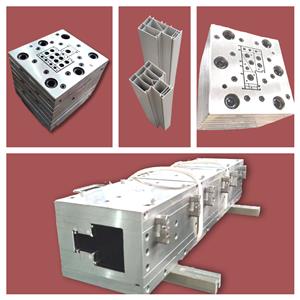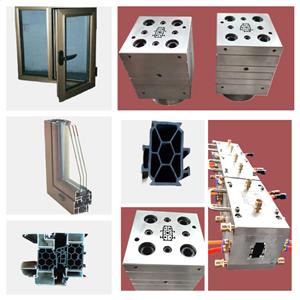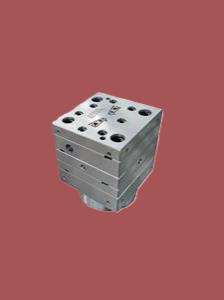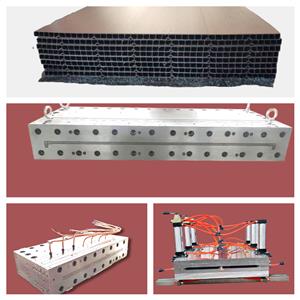-
1.What are the ways to judge the quality of extrusion molds?
The use of extrusion mold is also very common, if in use, the selection does not pay attention to the quality of the quality, will seriously affect the normal use of the extrusion mold, in order to make the mold get a good use, the following provides a specific way to judge the quality of the extrusion mold. First, look at the thickness of this mold, although the mold does not need to be used too vigorously or other harsh environments, but because of the repeated mold demolding, the mold is very easy to lose, deform, destroy, and the fundamental way to solve this problem is to thicken the thickness of the mold, so look at the thickness can clearly distinguish the grade of the mold. Second, see whether the specifications of the extrusion mold are standard, a good mold can control the size of the extruded plastic product produced in the error of a few tenths of a millimeter, and the inferior mold often produces a product error of several millimeters or even a few centimeters. Third, look at the material and workmanship of the entire mold, a good mold should be very smooth inside and outside, look shiny, and feel slightly moist and sinking, inferior molds may have burrs or potholes on the surface, and the comparison between the two is immediate.
-
2.Plastic machinery and plastic mold industry has become a high-growth development trend
Compared with metal, stone, wood, plastic products have the advantages of low cost, strong plasticity, etc., widely used in the national economy, plastic industry occupies an extremely important position in today's world, over the years the production of plastic products around the world at a high speed. Statistics show that China's plastic products production has always been in the forefront of the world ranking, among which a variety of plastic products have ranked first in the world, and China has become the world's largest producer of plastic products. From the perspective of demand, China's per capita plastic consumption is still far behind that of developed countries in the world. According to statistics, as an indicator to measure the development level of a country's plastics industry, the plastic-steel ratio in China is only 30:70, which is not as good as the world average of 50:50, and far less than the 70:30 of developed countries such as the United States and 63:37 of Germany. In the future, with the technological progress and consumption upgrading of modified plastics in China, China's plastic products need to maintain a growth rate of more than 10%. Plastic products are widely used, and the huge downstream industry provides strong support for the development of China's plastic products industry. With the introduction of the "Planning Rules for the Revitalization of the Petrochemical Industry", China's plastic products industry has ushered in new development opportunities. The survey report shows that the high-growth development trend of plastic machinery and plastic mold industry, as well as the steady development of light industries such as home appliances, food, beverages, leather and toys, are also favorable endogenous environments for the development of the plastics industry; The steady development of automobiles, medical plastics, real estate, especially affordable housing and other industries has increased the demand for plastic product manufacturers and become a favorable exogenous environment for the plastics industry. At the same time, the acceleration of exchange rate changes, the increase in the reserve requirement ratio and interest rates, the rise in raw material and labor costs, and the tight supply and demand of electricity, which are negative for most industries and enterprises, also plague the plastic products industry, forming a public bearish. On the basis of continuous breakthroughs in cutting-edge technologies in the plastics industry, we focus on the current key common core technologies and strive to narrow the gap between them and the high-tech production technologies of developed countries. The acceleration of technological progress will give plastic materials and plastic products more new functions to meet the needs of the national economy. Digital intelligent technology is the common enabling technology of product innovation and manufacturing technology innovation, and profoundly reforms the production mode and industrial form of the manufacturing industry, which is the core technology of the new industrial revolution. Lightweight technology will bring significant convenience to the development of the plastics industry. In the future, lightweight materials will be used more and more widely in automobiles, aircraft, and rail transit; Precision is a manifestation of advanced molding technology in the processing industry of plastic products industry, which is of great significance to the industry; Clean production and ecology have opened up a new step for energy conservation and emission reduction in the plastic processing industry.
-
3.Introduction to the principle and classification of plastic extrusion molds
First, the basic principle of plastic extrusion mold The word extrude is composed of the Latin words "ex" (leave) and "trudere" (push), and the brand vividly describes the whole process of extrusion "pressing raw materials according to molds". During the production process, Zhongjie extrusion molds usually add powder or granular polymer to the extruder barrel. Under the action of a screw or plunger pump, the polymer moves forward along the screw groove or cylinder and slowly melts into mucus. Then, according to the mold set on the top of the cylinder, a continuum similar to the injection mold is generated. After refrigeration molding, it can become a necessary product, such as various plastic hose rods, plastic plates, plastic steel windows, plastic films, decorative design baseboards, etc. Develop the total key points of plastic extrusion molds. Flame retardant plastic molds are a key component of extrusion manufacturing. The technical condition of flame-retardant plastic molds immediately affects the reliability of extrusion manufacturing, the quality of extruded products, extrusion productivity and the service life of the mold itself. Therefore, the design of flame-retardant plastic molds seems to be particularly critical. In the engine design scheme, the following key points should be noted: 1. The inner wall of the engine should be streamlined. In order to make the raw materials evenly squeezed along the engine flow channel and prevent excessive decomposition reaction of raw materials due to stagnation, it is never allowed to reduce the engine amplitude, not to mention the blind zone and stagnation zone, the runner should be smooth as much as possible, and the recommended appearance roughness Ra value is 0.4μm. 2. Adequate engine compression ratio. Depending on the plastic product and type of plastic, the design scheme can produce enough engine compression ratio engine to remove the fusion seams caused by the separation bracket and make the product dense. 3. Proper cross-sectional appearance. Due to the characteristics of the plastic, working pressure, relative density, shrinkage and other factors, the cross-sectional appearance formed by the opening of the engine mold is different from the true cross-sectional appearance of the product. This factor should be considered when designing the scheme to give the engine mold opening an effective cross-sectional appearance. 4. The rhythm is tight, which is conducive to disassembly. Under the premise of achieving physical performance, the engine should be formulated with a sense of rhythm, tight connection, symmetrical thermal conduction, easy disassembly, and no leakage. 5. The assembly is effective. The engine should use stainless steel plate with corrosion resistance, wear resistance, good compressive strength and high strength. Some should also use stainless steel depending on the situation. Second, the introduction of mold classification Molds can be divided into metal molds and non-metal molds. Metal molds are further divided into: casting molds (non-ferrous metal die casting, steel casting), and forging molds; Non-metallic molds are also divided into: plastic molds and inorganic non-metallic molds. According to the different materials of the mold itself, the mold can be divided into: sand mold, metal mold, vacuum mold, paraffin mold and so on. Among them, with the rapid development of polymer plastics, plastic molds are closely related to people's lives. Plastic molds can generally be divided into: injection molding molds, extrusion molding molds, gas-assisted molding molds and so on. Mass production of non-sheet metal steel parts - cold heading , die forging, metal molds, etc. Mold sheet metal discharge--hot rolling, cold rolling, hot coil, cold coil sheet metal processing--deep drawing, shaping, bending, punching, blanking non-ferrous metals - die casting, powder metallurgy plastic parts - injection molding, blow molding (plastic bottle), extrusion (pipe fittings) mold Other classification: alloy mold, sheet metal mold, plastic mold, stamping mold, casting mold, forging mold, extrusion mold, die casting mold, automobile mold, thread rolling mold, etc.
-
4.PVC plastic, the construction of the extrusion mold, unveils the veil for you
There are two forms of molds commonly used: plate stepped molds and cross-sectional gradient molds. The flow path of the plate stepped mold changes in steps, which is made of several mouth templates connected in series. Each plate is machined into a corresponding contour shape, which gradually changes from the round shape of the inlet to the desired outlet shape. There are bevels at the inlet of each block to complete the transition from one shape to another. This kind of mold processing cost is low, the flow channel is not ideal streamlined, and generally does not need to be used as the main profile. The section gradient mold runner is streamlined, there can be no retention zone of the material in the runner, the melt is gradually and accurately distributed to each section of the outlet shape from the circle at the inlet, and the speed is steadily increased to the required outlet speed, and the speed of each point on the section is the same. For PVC plastic profiles with complex mold cores, the mold core is either integrated with the bracket plate, some are fixed to the bracket plate by locating pins and screws, and some are embedded on the bracket plate by tight inlay. It cannot be easily disassembled during use, because it is time-consuming to reassemble and debug. The shunt of the melt is also carried out in two ways: on the shunt cone, and in the compression section. The section gradient mold can be used as the main profile mold. PVC plastic profile extrusion mold is the core part of the extrusion production line, which includes mouth die (also known as die head), shaping mold, cooling water tank, etc. The mouth die is assembled with the flange on the extruder head by means of a flange, and the heating ring, heating plate, power supply and thermocouple are connected. The shaping mold and cooling water tank are fixed to the shaping table with screws, and the water pipe and gas pipe are connected. The basic structure of the extrusion die is generally designed as a structure of multiple template stacked and assembled. Therefore, the flow channel of the entire die is formed by connecting one of the flow channels in each piece of the template, front and back. The platework is positioned and fastened with pins and bolts to form a monolithic extrusion die. The basic situation is: the steady flow section of the extrusion die is often composed of a perforated plate and the front half of the neck, and the front half and the second half of the neck are also designed as two templates, the neck and the neck transition plate. It is also possible not to use a porous plate, but to design the front half of the neck flow channel into a cylindrical flow channel to stabilize the flow. The split section of the extrusion die starts from the second half of the neck and includes the split cone, the split bracket plate, and the shrink plate. The shrink plate can be divided not into a single formwork, but together with the preformed plate - a formwork. The forming section of the extrusion die involves the following templates: cavity plate (also known as preformed plate), mouth template (also known as forming plate) and core (also known as mold core). For simpler profile dies, the preformed plate is combined with the mouth template into one formwork. 1. Key points of product cross-sectional design The key point of PVC plastic profile product design is that the thickness and shape of each section should be symmetrically distributed, so that the material flow in the machine head is balanced, the cooling can be uniform, and the pressure tends to be balanced. Generally speaking, the maximum wall thickness and the minimum wall thickness of the same section are different < 50% is appropriate. If it is a part of a closed rib, the thickness of the rib should be 20% thinner than the wall thickness. In order to avoid the stress concentration at the corner of PVC plastic profile products, the shape change of the product should be smooth and smooth transition, generally the outer corner R is not less than 0.5mm, the inner corner R is not less than 0.25mm. The hollow part of the product should not be too small. The cross-sectional shape is preferably symmetrical. 2. Structure type and design principle of mold The mold is the forming part of the extruder, which is mainly composed of neck seat, shunt cone, support plate (also known as bracket), core mold, mouth template and adjusting screw. PVC plastic profile extrusion die county is mainly composed of three sections: feeding section one by machine base and distribution cone composed of machine head flow channel feeding section, is conical: melt distribution and forming section one by support plate and mouth die compression part constitute melt distribution and forming section, the shape is gradually close to the PVC plastic profile section, parallel section mouth die and core die constitute the machine head parallel section, (1) There are two types of mold structure for extruded plastic profiles: plate head and streamlined head. According to the different methods of processing and manufacturing the machine head, the streamlined head fork is divided into integral streamlined and segmented (also known as stepped) streamlined. (2) Mold design principle The mold is the key part of PVC plastic profile extrusion, and its function is to extrude a blank similar to the profile under the action of 10~25MPa extrusion force. PVC plastic profile mold runner design principle is that the runner section should be streamlined: there is enough compression ratio and shaped length to form a certain extrusion pressure: the flow resistance balance and flow symmetry of the cross-sectional gap of each runner part of the mold. The flow channel structure of the PVC plastic profile head is generally divided into three parts: feeding, compression (also known as transition part) and forming. Generally speaking, the length of the feed part of the long runner is 1 of the length of the shaping part. About 5~2 times, the length of the compression part is about 2~3 times the length of the shaping part. The maximum cross-sectional area of the compression section is in the outlet area of the bracket. The shape of the support ribs of the bracketer. The broad one is jujube nucleus-shaped. The thin ones are long prismatic. The shape of the divergence in the front of the scaffold is that it converges at the same angle on all sides, forming a torpedo body shape. The flow rate of molten material is different in the flow channel of feeding, compression and forming, the feeding part is the smallest, the forming part is the largest, and the transition part must be in between the two and gradually increase in the direction of extrusion. The melt flow rate is inversely proportional to the cross-sectional area of the runner. The roughness of the runner in the head should be Ra0. 4~0.8ym, the roughness of the mouth mold runner of the stereotyped part is higher than the roughness of the inner runner, which should be Ra0.2~0. 4μm, When the extruded billet is just exported to the die, the size of the gap is increased than the mouth die, which is called the mold release expansion, that is, the Balas effect. This effect must be considered when the pulling speed of PVC plastic profile extrusion is slow and it is cooled near the outlet of the die mold. The release mold expansion of the outlet die is usually calculated by volume, and its expansion rate is generally 1.5~2.5 times, and this value changes with different aspects of melt temperature, pressure and velocity. The wall thickness size required for PVC plastic profiles depends on the wall thickness of the appropriate extruded billet on the one hand, and the pulling speed and extrusion amount on the other hand. The thickness of the extrusion blank wall mainly depends on the size of the mouth die gap, and then depends on the plasticizing performance of the material in the extruder, extrusion pressure, extrusion temperature, material performance and expansion value. First, the standard traction shrinkage rate for general wall thickness is ≤2.5%. The gap between the mouth die and the thickness of the product are taken (0.8~0.9) 1 1
-
5.Why Should Mold Processing Be Automated?
First, the challenges facing medium and large enterprises today The scale and number of equipment is huge Old and new devices coexist Gripper use is just starting – with increased precision Software and IT are less expensive and slower than hardware Hyper-high growth Copy the successful model to other plants Second, the dilemma encountered by the mold factory now Appearance and accuracy requirements are increased The exchange period is shortened High-end processing equipment must be used to meet the processing requirements Equipment usage cannot be increased→ manufacturing costs are high There is a shortage of labor, and the post-90s generation does not want to work in factories, let alone work night shifts Frequent job hopping of personnel, difficulty in technology inheritance→ inefficiency The scale is growing day by day, and management is difficult Third, the improvement of appearance and precision The accuracy of programming software 5 years ago: 10 ~ 15 um, Today: 2 ~ 5um 5 years ago, the front cover of a wall-mounted air conditioner had to be polished in 2 days, and now: 1 day to reduce the polishing of the mold is the primary means to improve the appearance quality of the product Fourth, the exchange period is shortened When Gree Dajin built a new factory in 2009, the processing time of the mold was halved, and the processing time of a set of wall-mounted air conditioning molds: 30 days 5 years ago and 10 days or less today Fifth, the demographic dividend has reached an irreversible turning point in Louis Sixth, the benefits of mold processing automation Every boss thinks about automation Increase competitiveness Processing efficiency, cost reduction Shorter lead times Improve quality Reduce reliance on labor Reduce labor Reduce human variability and error Improve corporate image Seventh, why do you want to engage in automation Basically, he has to look at the return on investment Return of Investment (ROI), how many years does Dehua earn back the money invested, for example, he invested 500,000 to buy every month, from this investment, he earned 15,000, and earned 180,000 a year, so his return on investment is: 50/18 = 2.78 years, most bosses, look at ROI < 2 years, 1.5 years ROI, it is easy to convince the boss, 2 years ROI is a little difficult to > 2 years general mountain is unlikely, unless it is a foreign-owned factory 8. How to calculate this account For example, the boss is considering investing in a robot for automation – 1 spark machine + 1 machining center, the total price of automation is 800,000, how does he calculate the ROI? Hourly machining cost and throughput of existing machine tools EDM = 80 55% VMC = 110 65% After the implementation of automation, the operating rate of the machine can be provided: EDM = 55% 95% 40% VMC = 65% 95% 30% of the extra machining time EDM = 40% = 9.6 hours x RMB 80 / hour = RMB 768 VMC = 30% = 7.2 hours x RMB 110 / hour = RMB 792 assumes that these machines can work 350 days a year, and at the end of the year his recycling: (768 + 792) x 350 = 546,000 Return on investment: 800,000 / 546,000 = 1.47 years
- What are the ways to judge the quality of extrusion molds?
- Plastic machinery and plastic mold industry has become a high-growth development trend
- Introduction to the principle and classification of plastic extrusion molds
- PVC plastic, the construction of the extrusion mold, unveils the veil for you
- Why Should Mold Processing Be Automated?




